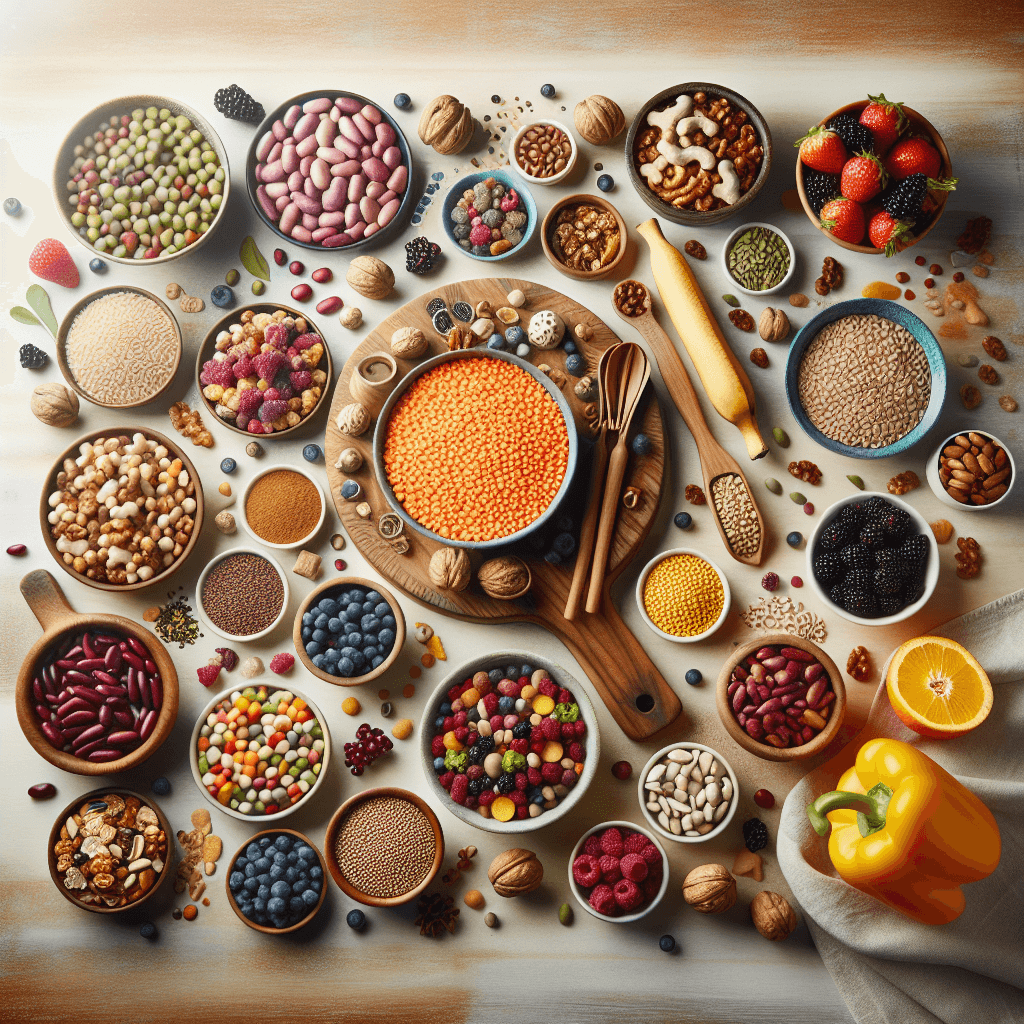Make Your Fibre Intake More Diverse: 12 Foods That Aren’t Green Vegetables
Published by Hindustan Times Health | Updated June 2024
Why Fibre Diversity Matters for Your Health
Fibre is an essential component of a healthy diet, supporting digestion, weight management, blood sugar control, and even mental health. Yet, many people associate fibre with green vegetables alone. According to a recent article by Hindustan Times, diversifying your fibre sources can significantly improve gut microbiome diversity, which is linked to better overall health.
For people with food sensitivities, allergies, or specific dietary preferences (such as gluten-free, vegan, or low-FODMAP diets), relying solely on green vegetables for fibre may not be feasible or enjoyable. Fortunately, a wide array of non-green, fibre-rich foods can help you meet your daily fibre needs while catering to your unique requirements.
How Much Fibre Do You Need?
According to the Indian Council of Medical Research (ICMR) and World Health Organization (WHO), adults should aim for at least 25-35 grams of dietary fibre per day. However, most people consume less than half of this amount. Increasing fibre intake from a variety of sources can help bridge this gap, support digestive health, and reduce the risk of chronic diseases such as type 2 diabetes, heart disease, and certain cancers (PMID: 37201044, 2023).
12 Fibre-Rich Foods That Aren’t Green Vegetables
Let’s explore 12 delicious and diverse foods that can boost your fibre intake, support your gut, and fit a variety of dietary needs.
-
1. Lentils
Lentils are a powerhouse of nutrition, offering both soluble and insoluble fibre. A single cup of cooked lentils delivers up to 15 grams of fibre. They are naturally gluten-free, low in FODMAPs (when prepared properly), and suitable for vegans and vegetarians. Lentils also contain plant-based protein, iron, and folate, making them a staple for balanced diets.
-
2. Chia Seeds
Tiny but mighty, chia seeds provide a whopping 10 grams of fibre per two-tablespoon serving. They are an excellent choice for people with gluten sensitivities and can be added to smoothies, yogurts, or baked goods. Chia seeds also offer omega-3 fatty acids and are suitable for most dietary preferences.
-
3. Oats
Oats are a versatile whole grain, rich in beta-glucan soluble fibre, which supports heart health and helps regulate blood sugar. A cup of cooked oats contains about 4 grams of fibre. Opt for certified gluten-free oats if you have celiac disease or gluten intolerance. Oats are also low in FODMAPs and can be enjoyed as porridge, overnight oats, or in baked snacks.
-
4. Apples (with Skin)
Apples are a convenient, portable source of fibre, especially when eaten with the skin. One medium apple offers about 4 grams of fibre, including pectin, a prebiotic fibre that nourishes gut bacteria. Apples are naturally low in calories, hydrating, and suitable for most diets. For those sensitive to FODMAPs, smaller portions may be better tolerated.
-
5. Sweet Potatoes
Sweet potatoes are not only rich in vitamin A but also provide 4 grams of fibre per medium tuber (with skin). They are gluten-free, lower in FODMAPs than regular potatoes, and can be roasted, mashed, or added to salads for a fibre boost.
-
6. Quinoa
Quinoa is a pseudo-cereal that’s naturally gluten-free and rich in both fibre (about 5 grams per cooked cup) and complete protein. It’s an excellent alternative to rice or wheat for those with sensitivities and can be used in salads, bowls, or as a breakfast porridge.
-
7. Raspberries
Among fruits, raspberries are a standout, offering 8 grams of fibre per cup. They are low in sugar, high in antioxidants, and suitable for most dietary needs. Raspberries can be enjoyed fresh, frozen, or blended into smoothies for a colourful fibre boost.
-
8. Almonds
A handful of almonds (about 23 nuts) provides 3.5 grams of fibre, along with healthy fats, vitamin E, and magnesium. Almonds are gluten-free, vegan, and suitable for low-carb diets. For those with nut allergies, sunflower seeds or pumpkin seeds can be a great alternative.
-
9. Brown Rice
Brown rice retains its bran layer, offering more fibre (about 3.5 grams per cooked cup) than white rice. It’s naturally gluten-free and fits into most dietary patterns. For those with sensitive digestion, soaking brown rice before cooking can help improve its digestibility.
-
10. Psyllium Husk
Psyllium husk is a concentrated source of soluble fibre, often used to support digestive regularity. Just one tablespoon provides 5 grams of fibre. It’s tasteless and can be mixed into water, smoothies, or gluten-free baking. Psyllium is suitable for most diets but should be introduced gradually to avoid bloating.
-
11. Popcorn (Air-Popped)
Air-popped popcorn is a whole grain snack that offers 3.5 grams of fibre per 3-cup serving. It’s gluten-free, low in calories, and can be seasoned to taste. Avoid varieties with added butter or artificial flavours for a healthier option.
-
12. Beans (Kidney, Black, Pinto)
Beans are among the highest-fibre foods, with up to 15 grams per cooked cup. They are rich in plant protein, iron, and folate. Beans can be enjoyed in soups, salads, or dips. For individuals sensitive to FODMAPs, soaking and rinsing beans thoroughly or opting for canned varieties can help reduce digestive discomfort.
Fibre for Food Sensitivities and Dietary Preferences
Many people struggle to find fibre-rich foods that align with their dietary restrictions. Here’s how you can diversify your fibre intake while respecting your unique needs:
- Gluten-Free: Choose naturally gluten-free grains like quinoa, brown rice, and certified gluten-free oats.
- Low-FODMAP: Opt for oats, chia seeds, quinoa, and small servings of berries or apples (peeled if needed).
- Vegan/Vegetarian: Lentils, beans, seeds, and nuts are excellent sources of fibre and plant protein.
- Nut Allergies: Substitute nuts with seeds (sunflower, pumpkin, chia) for similar fibre benefits.
- Low-Carb/Keto: Psyllium husk, chia seeds, and nuts offer fibre without excess carbs.
Recent research (PMID: 37567098, 2023) highlights the importance of fibre diversity, not just quantity, for optimal gut microbiome health. A varied fibre intake supports a broader range of beneficial bacteria, which can help reduce inflammation, support immunity, and improve mood.
How to Add More Fibre to Your Diet: Practical Tips
- Start slow: Increase fibre intake gradually to avoid bloating or discomfort.
- Drink plenty of water: Fibre works best when paired with adequate hydration.
- Mix and match: Combine different fibre sources in meals (e.g., oats with berries and chia seeds).
- Snack smart: Choose high-fibre snacks like popcorn, nuts, or fruit with skin.
- Read labels: Look for whole grains and unprocessed foods for higher fibre content.
Leveraging Digital Tools: Food Scan Genius and Yuka
For those with food sensitivities or specific dietary goals, digital tools can simplify the process of finding suitable, fibre-rich foods:
- Food Scan Genius: This app allows you to scan food barcodes and instantly view nutritional content, including fibre, allergens, and suitability for various diets. It’s especially helpful for those managing allergies or intolerances, as it flags ingredients to avoid and suggests alternatives.
- Yuka: Yuka rates packaged foods based on their nutritional quality, including fibre content, additives, and processing level. It helps users make informed choices by highlighting healthier, high-fibre options and suggesting swaps for less nutritious products.
By integrating these tools into your grocery shopping and meal planning, you can easily identify diverse, fibre-rich foods that align with your health needs and preferences.
Fibre Diversity and Gut Health: What the Latest Science Says (2023-2024)
A 2023 review in Frontiers in Nutrition emphasizes that consuming a wide range of fibre types (soluble, insoluble, fermentable, non-fermentable) from different sources is more beneficial for gut microbiome diversity than focusing on a single food group. This diversity is linked to reduced inflammation, improved metabolic health, and better mental well-being.
Another study (PMID: 37567098, 2023) found that individuals who consumed at least 8-10 different fibre sources per week had a more resilient gut microbiome and lower rates of digestive disorders. This supports the recommendation to diversify your fibre intake beyond green vegetables.
Conclusion: Embrace Fibre Diversity for Better Health
Making your fibre intake more diverse doesn’t have to mean endless salads or steamed greens. By incorporating a variety of delicious, fibre-rich foods like lentils, chia seeds, oats, fruits, nuts, and whole grains, you can support your gut, meet your dietary needs, and enjoy a more satisfying diet.
Whether you’re managing food sensitivities, following a specific diet, or simply looking to improve your health, these 12 foods provide easy, accessible ways to boost your fibre intake. Leverage digital tools like





